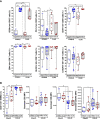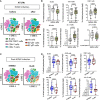Changes in HCMV immune cell frequency and phenotype are associated with chronic lung allograft dysfunction
- PMID: 37187736
- PMCID: PMC10175754
- DOI: 10.3389/fimmu.2023.1143875
Changes in HCMV immune cell frequency and phenotype are associated with chronic lung allograft dysfunction
Abstract
Background: Human cytomegalovirus (HCMV) infection is common and often severe in lung transplant recipients (LTRs), and it is a risk factor associated with chronic lung allograft dysfunction (CLAD). The complex interplay between HCMV and allograft rejection is still unclear. Currently, no treatment is available to reverse CLAD after diagnosis, and the identification of reliable biomarkers that can predict the early development of CLAD is needed. This study investigated the HCMV immunity in LTRs who will develop CLAD.
Methods: This study quantified and phenotyped conventional (HLA-A2pp65) and HLA-E-restricted (HLA-EUL40) anti-HCMV CD8+ T (CD8 T) cell responses induced by infection in LTRs developing CLAD or maintaining a stable allograft. The homeostasis of immune subsets (B, CD4T, CD8 T, NK, and γδT cells) post-primary infection associated with CLAD was also investigated.
Results: At M18 post-transplantation, HLA-EUL40 CD8 T responses were less frequently found in HCMV+ LTRs (21.7%) developing CLAD (CLAD) than in LTRs (55%) keeping a functional graft (STABLE). In contrast, HLA-A2pp65 CD8 T was equally detected in 45% of STABLE and 47.8% of CLAD LTRs. The frequency of HLA-EUL40 and HLA-A2pp65 CD8 T among blood CD8 T cells shows lower median values in CLAD LTRs. Immunophenotype reveals an altered expression profile for HLA-EUL40 CD8 T in CLAD patients with a decreased expression for CD56 and the acquisition of PD-1. In STABLE LTRs, HCMV primary infection causes a decrease in B cells and inflation of CD8 T, CD57+/NKG2C+ NK, and δ2-γδT cells. In CLAD LTRs, the regulation of B, total CD8 T, and δ2+γδT cells is maintained, but total NK, CD57+/NKG2C+ NK, and δ2-γδT subsets are markedly reduced, while CD57 is overexpressed across T lymphocytes.
Conclusions: CLAD is associated with significant changes in anti-HCMV immune cell responses. Our findings propose that the presence of dysfunctional HCMV-specific HLA-E-restricted CD8 T cells together with post-infection changes in the immune cell distribution affecting NK and γδT cells defines an early immune signature for CLAD in HCMV+ LTRs. Such a signature may be of interest for the monitoring of LTRs and may allow an early stratification of LTRs at risk of CLAD.
Keywords: CD8 T cells; CMV; HCMV immunity; HCMV infection; HLA-E; UL40; chronic lung allograft dysfunction; transplantation.
Copyright © 2023 Rousselière, Delbos, Foureau, Reynaud-Gaubert, Roux, Demant, Le Pavec, Kessler, Mornex, Messika, Falque, Le Borgne, Boussaud, Tissot, Hombourger, Bressollette-Bodin and Charreau.
Conflict of interest statement
The authors declare that the research was conducted in the absence of any commercial or financial relationships that could be construed as a potential conflict of interest.
Figures







References
-
- Chambers DC, Cherikh WS, Goldfarb SB, Hayes D, Jr., Kucheryavaya AY, Toll AE, et al. . The international thoracic organ transplant registry of the international society for heart and lung transplantation: thirty-fifth adult lung and heart-lung transplant report-2018; focus theme: multiorgan transplantation. J Heart Lung Transplant (2018) 37(10):1169–83. doi: 10.1016/j.healun.2018.07.020 - DOI - PubMed
-
- Chambers DC, Yusen RD, Cherikh WS, Goldfarb SB, Kucheryavaya AY, Khusch K, et al. . The registry of the international society for heart and lung transplantation: thirty-fourth adult lung and heart-lung transplantation report-2017; focus theme: allograft ischemic time. J Heart Lung Transplant (2017) 36(10):1047–59. doi: 10.1016/j.healun.2017.07.016 - DOI - PubMed
-
- Kulkarni HS, Cherikh WS, Chambers DC, Garcia VC, Hachem RR, Kreisel D, et al. . Bronchiolitis obliterans syndrome-free survival after lung transplantation: an international society for heart and lung transplantation thoracic transplant registry analysis. J Heart Lung Transplant (2019) 38(1):5–16. doi: 10.1016/j.healun.2018.09.016 - DOI - PMC - PubMed
Publication types
MeSH terms
LinkOut - more resources
Full Text Sources
Medical
Research Materials

